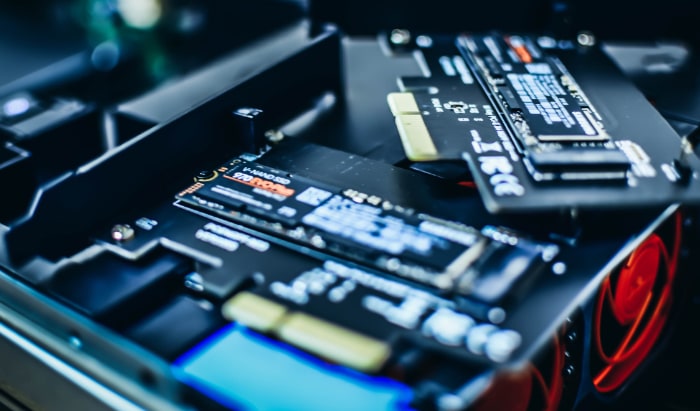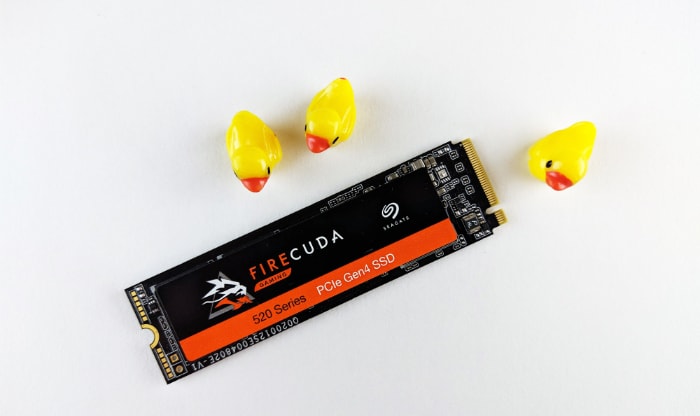Storage Wars: M.2 SATA vs. M.2 PCIe SSDs Unveiled

Solid State Drives (SSDs) have revolutionized the world of data storage with their impressive speed, compact size, and resilience. A particular type of SSD, known as the M.2 SSD, has been steadily gaining popularity among tech enthusiasts and professionals alike due to its exceptional performance and form factor.
M.2 SSDs come in two key variants: M.2 SATA and M.2 PCIe, each with its unique architecture and performance characteristics.
Understanding the differences between M.2 SATA and M.2 PCIe SSDs is crucial for anyone seeking to enhance their system’s storage performance. Whether you’re a gamer wanting to reduce load times, a content creator needing fast access to large files, or a general user seeking a responsive computer, choosing the right type of M.2 SSD can have a significant impact on your computing experience.
Understanding M.2 SSDs: A Deep Dive into Compact Storage
M.2 Solid State Drives (SSDs) represent a significant step forward in storage technology. These are compact, card-based storage devices that provide superior speeds and performance compared to traditional Hard Disk Drives (HDDs).
M.2 SSDs are named after their form factor, M.2, which is an interface specification developed by the Serial ATA International Organization.
The Evolution of M.2 SSDs
Before the advent of M.2 SSDs, most computers relied on the older 2.5″ SATA SSD or HDD form factor. However, these larger drives often failed to meet the size and performance demands of modern, slim devices like ultrabooks and high-performance desktops.
The introduction of the M.2 standard marked a shift toward smaller, faster, and more efficient storage solutions. M.2 SSDs come in various lengths, but all feature a width of 22mm, allowing them to fit into the tightest of spaces, including thin laptops and small form factor (SFF) PCs.
M.2 SSDs: More Than Just Size
While their compact size is indeed a significant advantage, M.2 SSDs offer more than just a space-saving design. They also support multiple data transfer protocols, including SATA and PCIe, each with its own unique set of advantages and trade-offs.
The SATA (Serial ATA) protocol, used by M.2 SATA SSDs, is the same one used by traditional SATA SSDs and HDDs. While SATA-based M.2 SSDs offer a significant performance boost over HDDs, they are somewhat limited by the SATA protocol’s speed constraints.
On the other hand, M.2 SSDs using the PCIe (Peripheral Component Interconnect Express) protocol, such as M.2 PCIe SSDs, can achieve even higher data transfer rates. This is thanks to the direct connection PCIe has to the CPU, bypassing the slower SATA bus.
Flexibility and Versatility
M.2 SSDs also offer versatility in terms of their keying, which determines the type of socket they can be plugged into. There are several types of keys, including B, M, and B+M, which correspond to different types of sockets on the motherboard.
This flexibility makes M.2 SSDs compatible with a wide range of devices, from desktops and laptops to gaming consoles and enterprise servers.
In-depth Analysis: M.2 SATA SSDs – Unpacking the Details
M.2 SATA SSDs represent a combination of the M.2 form factor and the SATA protocol. Despite the compact size offered by the M.2 form factor, these SSDs operate on the same SATA III interface as traditional 2.5-inch SSDs and HDDs.
This interface allows a maximum data transfer rate of 6 Gb/s (gigabits per second).
Architecture and Operation
The architecture of M.2 SATA SSDs is designed for seamless compatibility with SATA-based systems. These drives plug into M.2 slots on the motherboard that are specifically keyed for SATA compatibility.
The SATA controller within the system then communicates with the M.2 SATA SSD, enabling the data transfer process.
Key Features and Benefits of M.2 SATA SSDs
Compact Form Factor: M.2 SATA SSDs offer the compactness of the M.2 form factor, enabling their use in slim and compact devices.
Compatibility: Given their operation on the SATA protocol, M.2 SATA SSDs are widely compatible with many existing systems.
Sufficient Speed: Although not as fast as M.2 PCIe SSDs, M.2 SATA SSDs still offer significant performance gains over traditional HDDs.
Limitations of M.2 SATA SSDs
Speed Constraints: The speed of M.2 SATA SSDs is limited by the SATA III interface, which caps at 6 Gb/s. This can potentially create a bottleneck in systems that demand high-speed data transfer.
Limited Future-Proofing: As the technology world moves towards faster protocols like PCIe, the SATA-based M.2 SSDs might not offer the best future-proofing for your system.
Ideal Use-Cases for M.2 SATA SSDs
M.2 SATA SSDs are best suited for mainstream computing, where the performance demand is not exceptionally high. They are an excellent choice for users seeking faster boot times, quicker application load times, and overall system responsiveness without the need for extreme data transfer speeds.
In-depth Analysis: M.2 PCIe SSDs – Delving into High-Speed Storage

M.2 PCIe (Peripheral Component Interconnect Express) SSDs are advanced storage devices that leverage the M.2 form factor and the high-speed PCIe interface. The PCIe interface has a direct connection to the CPU, eliminating the bottleneck often experienced with the SATA III protocol.
As a result, M.2 PCIe SSDs can offer incredibly fast data transfer rates, significantly surpassing those of M.2 SATA SSDs.
Architecture and Operation
M.2 PCIe SSDs plug into M.2 slots on the motherboard that are specifically keyed for PCIe compatibility. They utilize multiple PCIe lanes for data transfer, each providing a separate link between the SSD and the CPU.
The number of lanes commonly ranges from one to four, but it can be higher in certain enterprise-level SSDs.
Key Features and Benefits of M.2 PCIe SSDs
High-Speed Performance: M.2 PCIe SSDs can reach speeds significantly higher than SATA SSDs due to the PCIe interface’s direct connection to the CPU.
NVMe Support: Many M.2 PCIe SSDs also support NVMe (Non-Volatile Memory Express), a protocol specifically designed for high-speed storage media, further boosting their performance.
Compact Form Factor: Like M.2 SATA SSDs, M.2 PCIe SSDs also benefit from the compact M.2 form factor, allowing use in slim and compact devices.
Limitations of M.2 PCIe SSDs
Higher Costs: M.2 PCIe SSDs are typically more expensive than their SATA counterparts due to their superior performance.
Potential Heat Generation: Due to their high-speed operation, M.2 PCIe SSDs can generate more heat than M.2 SATA SSDs, which might require additional cooling solutions in some cases.
Compatibility: Older motherboards may not support PCIe or NVMe, limiting the usability of M.2 PCIe SSDs in such systems.
Ideal Use-Cases for M.2 PCIe SSDs
M.2 PCIe SSDs are ideal for high-performance computing, such as gaming, video editing, and 3D rendering, where high-speed data access is critical. They are also suitable for professionals who frequently work with large files and demand quick data transfer.
Finally, due to their superior speed, M.2 PCIe SSDs are an excellent choice for future-proofing your system.
Comparative Analysis: Weighing the Differences
Speed Comparison: How They Measure Up
M.2 SATA SSDs offer speeds limited to the SATA III interface’s maximum bandwidth, typically around 600 MB/s (megabytes per second). On the other hand, M.2 PCIe SSDs, especially those supporting NVMe, can achieve significantly higher speeds.
Depending on the number of PCIe lanes they use, these SSDs can reach speeds of up to 3500 MB/s or even higher.
Performance Differences in Real-World Applications
Although M.2 PCIe SSDs are faster on paper, the difference in real-world applications may not always be as pronounced. For everyday computing tasks such as web browsing, document editing, and multimedia playback, both types of SSDs will deliver similar performance.
However, in data-intensive tasks such as game loading, high-resolution video editing, 3D rendering, and large database operations, the superior speed of M.2 PCIe SSDs will become evident.
Cost Comparison
In general, M.2 SATA SSDs are more affordable than M.2 PCIe SSDs. The higher cost of M.2 PCIe SSDs is attributable to their superior speed and performance. It’s important to assess your specific needs and budget constraints before making a choice.
Compatibility Differences
M.2 SATA SSDs offer broader compatibility, as they can operate on the SATA interface that is common on most motherboards. However, M.2 PCIe SSDs require motherboards with PCIe slots that also support the NVMe protocol for maximum performance.
Although most modern motherboards include this support, older systems may not.
Power Consumption and Heat Generation Comparison
M.2 PCIe SSDs, due to their high-speed operation, typically consume more power and generate more heat than M.2 SATA SSDs. This might require additional cooling measures, especially in high-performance systems or compact builds with limited airflow.
Future-Proofing
When it comes to future-proofing your system, M.2 PCIe SSDs have the upper hand. Their support for the latest protocols (like NVMe) and superior speed make them a more forward-looking choice.
Although M.2 SATA SSDs offer sufficient performance for many current tasks, they might not hold up as well in the face of advancing technology and increasing data demands.
Conclusion: Deciphering the Right M.2 SSD for Your Needs
In our exploration of M.2 SATA and M.2 PCIe SSDs, it becomes evident that both types of storage devices have their unique strengths and applications. M.2 SATA SSDs, with their broad compatibility and cost-effectiveness, offer a significant upgrade over traditional HDDs and are a suitable choice for mainstream computing tasks.
On the other hand, M.2 PCIe SSDs, with their incredibly high speeds and forward-looking technology, are ideal for high-performance computing and future-proofing your system.
However, the ultimate choice between M.2 SATA and M.2 PCIe largely depends on your specific needs, your system’s compatibility, and your budget. Are you seeking maximum speed for high-performance computing, or are you more concerned with cost and compatibility? Answering these questions will guide you toward the right choice for your system.
Remember, technological evolution is a constant process. As we continue to demand more from our systems, the industry will persist in its pursuit of faster, more efficient storage solutions.
Staying informed about these advancements can help you make optimal choices, enhancing your digital experience.
In the end, whether you choose an M.2 SATA or M.2 PCIe SSD, the shift from a traditional HDD to an M.2 SSD is a leap forward, promising a significant performance improvement and a smoother, more responsive computing experience.


